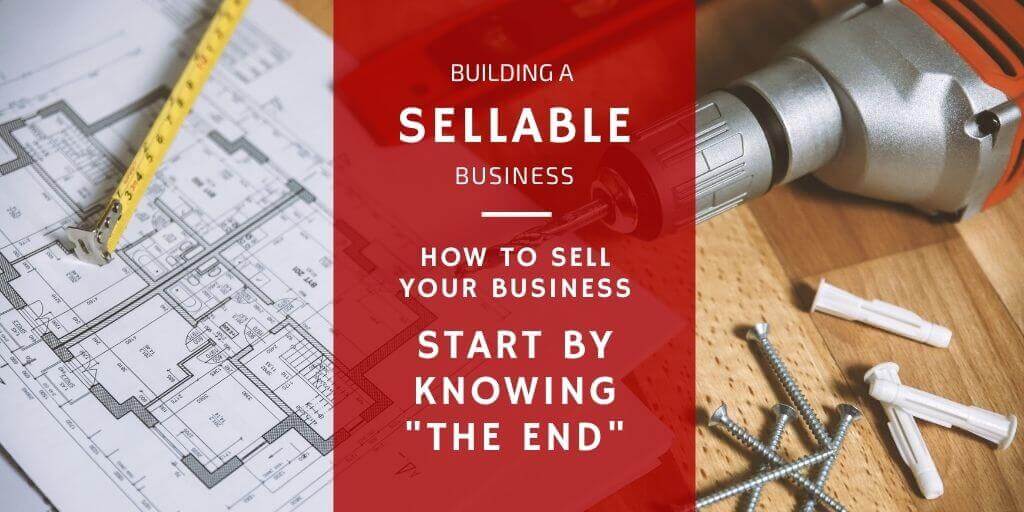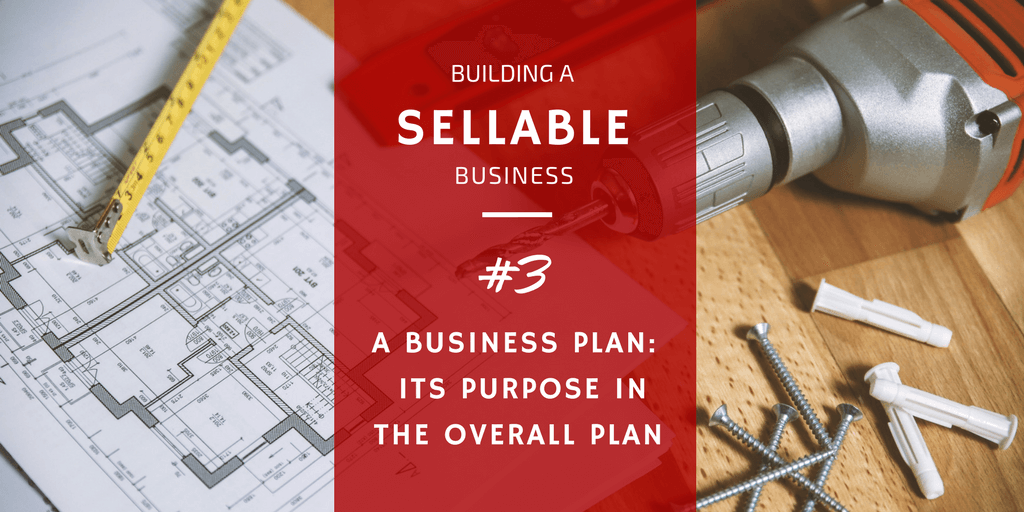
Selling Your Business 101 – The Financially Simple Guide
October 17, 2017
Mastering Competitive Advantage… A Key to Increasing Business Value – Post #4
October 26, 2017A Business Plan: Its Effect on the Saleability of a Business – Article #3

In my most recent article in this Building a Sellable Business series, Selling your Business… Starting at the end, I explained that you can’t begin a business if you don’t know how it’s going to end. You have to identify why you are working before you can figure out how to work wisely. You must recognize the intrinsic value within your business and then work to increase, or accelerate that value purposefully and strategically. And one of the best ways to start that process is by building a plan… a business plan.
Podcast Time Index for “A Business Plan: Its Purpose in Building a Sellable Business”
00:32 – Business Planning, a Recurring Foundation
00:57 – Cowboys, Rodeos, and Small Businesses Foundations
05:13 – Recurring Foundations, Annual Business Planning
05:35 – What is a Business Plan
05:50 – The Company Description
06:09 – Market Analysis
06:52 – Organizational Structure
08:30 – Product/Service Line
09:40 – Marketing
11:09 – Funding
12:37 – Financial Projections
15:08 – Pro-forma Requires for Selling
17:49 – Appendix
18:09 – The Summary
19:10 – Why develop a Business Plan
21:32 – In Conclusion
Have you ever scratched your head and wondered why some business owners soar? Nothing seems to hold them back from more: more money, more clients, more contracts, more products, more everything. While those entrepreneurs are taking the bull by the horns, other business owners are getting run over by the bull. They can’t get out of the trenches. They’re stuck in the everyday business muck and mire, and they’re getting trampled by the bull.
I’m sure you’ve heard the bull riding adage. In fact, you may even use it. Why do I apply it to business owners?
Bull Riding
Let me set the stage for you. My family and I love to go to the rodeo. We love the small community atmosphere, we love all of the junk food, and wholesome entertainment. It’s just good country folk coming together riding horses, roping steers, and riding bulls.
I don’t know if you’ve ever witnessed the bull riding event at a rodeo in person, but it’s something to behold. There are these enormous bulls, these massive slabs of steak, corralled and ready to buck. These things are 2000-3000 pounds, and all I can think is, “What a T-Bone!” They are huge! I’m sure you’ve seen a rodeo on TV or heard about it in a song, but when you’re watching it in person, you can actually see the saliva dripping from the bull’s mouth. You can see the anger in his eyes when wranglers prod him and motivate him to buck.
Waiting in the wings, you have a scraggly rodeo rider, or bull rider, who’s probably 180 pounds soaking wet. Momentarily, he gets on the back of this beast that’s easily ten times his weight with the goal of riding him for eight seconds. At least, that’s the idea.
Of course, the audience loves it when a rider can stay on the bull for the full eight seconds. The buzzer goes off, the arena goes wild, fans start cheering, the rider jumps off the beast and waves his hat in the air, and all you want to do is walk out and give the guy a fist bump. What a man!
How many times have we seen somebody fall off the bull, though? We’ve seen a rider get dragged around with his hand caught in the lanyard and one gets thrown around like a ragdoll. Inevitably, the bull tramples a rider or gores him with its horns. The audience cringes, the rodeo clowns rush in, and medics tend to the rider.
How Does this Relate to Me?
Isn’t the bull a lot like a business? Think about it. We watch friends open a company and ride the bull of business like it’s a tame pony ride. I mean, they could be in the most cut-throat, grisliest, meanest market ever seen, and these entrepreneurs are wrangling problem steers and having the time of their lives. They get it all – the cheers from the crowd, the belt buckle, the picture with the pretty girl, the big money.
But then, you’ve got the others – your business owner friends who never reach elite status. They get trampled, and when they’re already down, they’re wallowing around in bull crap. Literally. But why? Why can’t some business owners ever tame the business bull? What gets them caught in the muck?
What Do The Two Owners Do Differently?
When I talk to clients, both the ones who are worth millions of dollars and the ones who are forever in the red, I try to find the answer to those questions. Oftentimes, I ask them, “If you had it to do all over again, what would you do differently?” Perhaps the most helpful response I’ve ever gotten came from a buddy of mine who owns multiple businesses and is worth eight million dollars. After some thought, he said, “You know; if I could have done it differently, I would have planned better. I didn’t have a clue what I was doing. Somebody told me I should have a plan but just didn’t see the purpose of a business plan. Man, the first six years of my career was just nightmarish, but when I finally sat down and did a business plan, my life came together.”
I’ve thought about what my friend said a lot. As I’ve stepped in to help clients wading in the business quagmire, I’ve looked to see if they had a business plan. I’ve asked my successful clients to show me their business goals and outlines. For several years now, I’ve tested my friend’s assertion, and I’ve found it to be accurate.
Inevitably, I’ve seen that the business owners who have the bull by the horns create and follow a business plan. They don’t just write one and look at it 20 years later, though. Yearly, monthly, and weekly they succeed by tweaking what’s not working to make it work. Their plan is foundational to their success, and it grows with them, flexing with the market and with the individual’s circumstances. That’s why I’ve titled this article, A Business Plan: Its Purpose in Building a Sellable Business.
Business owners have to start somewhere. They have to lay the original groundwork for success. Yet, they can’t stop there. They have to test the foundation. Upon re-evaluation, they have to add support to it. They can’t neglect the base of their business structure, or their entire company will crumble.
What is Included in a Business Plan?
Since I’ve told you that a good business plan is essential, or foundational to your business’s success, you need to know what’s in one. Here is an overview of the basics:
- Company description
- Market analysis
- Management and ownership
- Service/Product line
- Marketing & Sales
- Funding
- Financial projections
- Appendix
- Business Summary
I wrote a comprehensive article recently about exactly what needs to be in a good business plan, and it’s received all sorts of press. In this article, I dove into every aspect giving step-by-step instructions, and suggestions. Use that page as your starting point if you don’t have a business plan, or revisit it if you already have one.
The Purpose of a Business Plan… to Become the Business Foundation
In order to grow your company to sell it, creating a business plan at the beginning of your journey AND at the beginning of each year is fundamental to know what you’re trying to accomplish. Not only that, knowing what you want to achieve determines how well you succeed. How do you know you’ve reached your destination if you had none in mind? What determines your business’s success if you’ve never defined success for your business?
Yes, a business plan is time-consuming and frustrating, and that’s not what we entrepreneurs want to hear. We have an amazing product or an incredible service, and we want to jump right into business and get that product or service to our customers who must be desperate for what we have to offer. Let’s make big money now. Back up. Timeout. You’re going to become that guy who gets thrown off the bull and trampled. I challenge you to stop. Stop right now. No matter where you are in your business’s life cycle, take the time to write out a business plan.
When our team built a business plan a few years ago, we clearly defined who we wanted to work with, what we wanted to offer, and how we would provide it. Our team projected a gain of 25% per year, but because all of us were working on the same goals and moving in the same direction, we actually averaged 50% growth per year. That’s double the revenue we anticipated!
The Business Foundation Drives the Business’s Success
We didn’t reach success by creating a one-and-done business plan and walking away from it. The theory became practice, and then practice became routine. We laid out one-year revenue, product, service, improvement, and sales goals. Each team member contributed thoughts and ideas, and we all bought into them before we put them on paper. We needed the whole team pulling in the same direction.
After building our business plan, we broke up our goals into 90-day sprints where we focused on one key item. One. Now that key item was multi-faceted, but we stuck to one item every 90 days. Within our sprints, we met monthly to evaluate our progress to reach the goal. Often, we met weekly to assess what we needed to do in order to reach our monthly goal. Our entire focus was on achieving the goals we created as a team and holding each other accountable for reaching those goals.
The business plan propelled us forward. It provided us with motivation and inspiration. When we met each short-term goal, we celebrated, knowing that we could achieve our “ultimate goal.” For us, the business plan was THE tool for monthly, quarterly, and yearly success.
Business Success Makes a Business Sellable
It’s not just our team, folks. We’re helping clients all over the United States grow their businesses to sell them by creating a recurring foundation in the form of a business plan. I don’t care if you have 1 employee, 10 employees, or 300 employees. Every business has to get the employees, their team members, to buy into the business’s goal. If the team gets it, they’re happier, they’re more fulfilled, and they’re more motivated. They hold themselves and each other accountable. They propel you to greatness and your business to success.
Stop giving excuses. Quit saying you don’t have time. Stop. Make time. Wherever you are in your business’s life cycle or whatever time of year you hear this, make a business plan. You think you don’t have time, but you don’t have the time to waste by spinning your wheels without direction. Make the time.
Let’s continue to make your life, at least, financially simple… by building your business’s competitive advantage over its competitors.
Do you have a written business plan? When is the last time it was updated? The business plan is vital to your success but you don’t have to get stuck in the weeds with it. Reach out to us to learn how we could help you to develop, review, and/or update your business plan!



